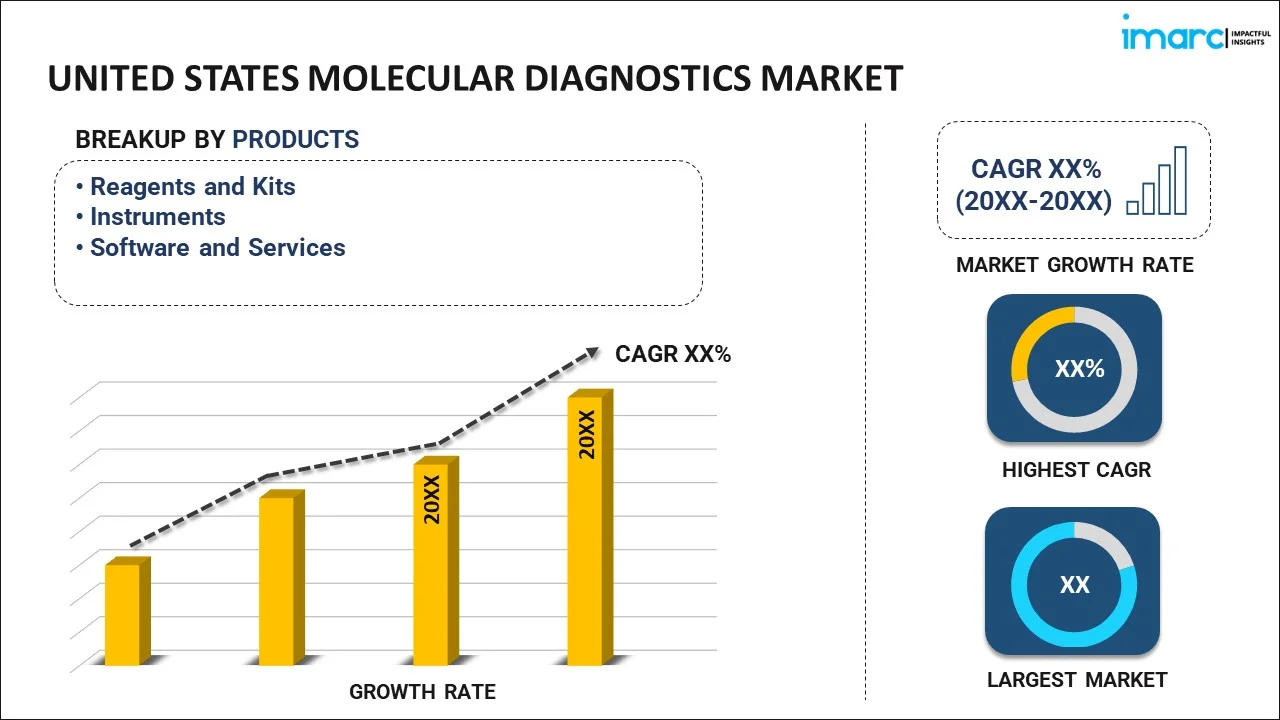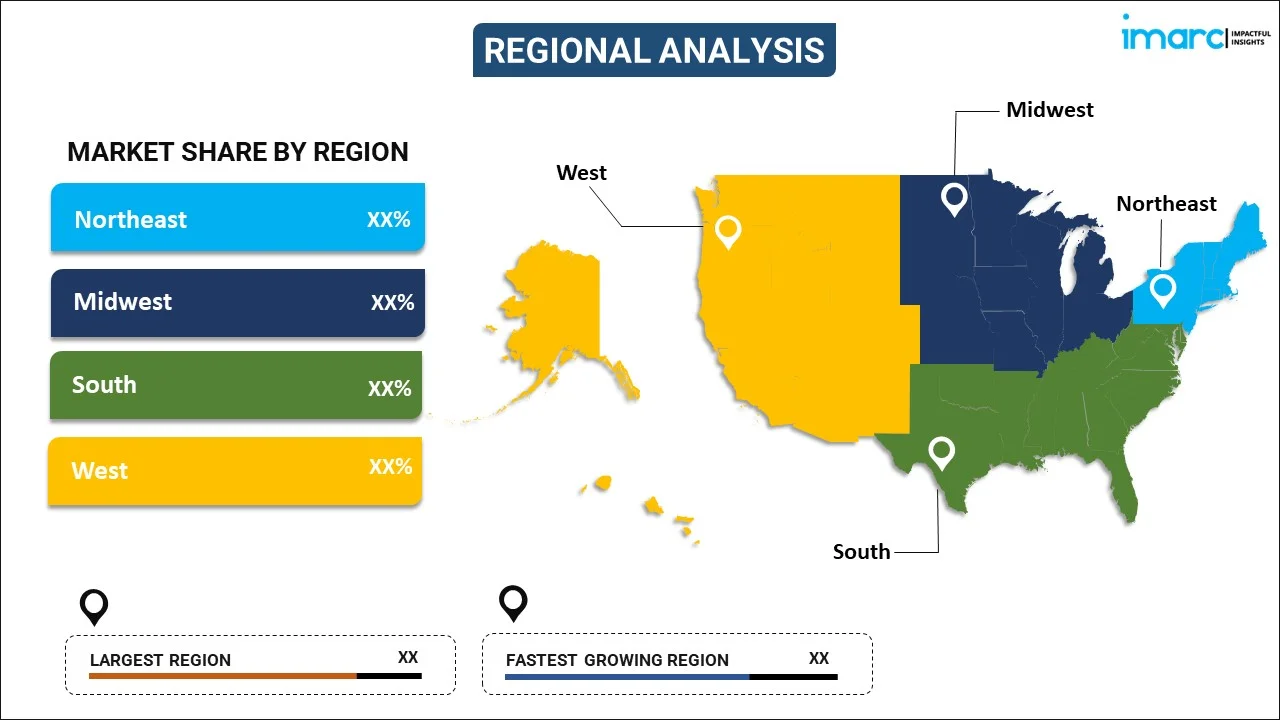
United States Molecular Diagnostics Market Report by Product (Reagents and Kits, Instruments, Software and Services), Technology (Polymerase Chain Reactions (PCR), Hybridization, DNA Sequencing, Microarray, Isothermal Nucleic Acid Amplification Technology (INAAT), and Others), Application (Infectious Diseases Diagnostics, Oncology, Genetic Testing, Blood Screening, and Others), End User (Hospitals, Laboratories, and Others), and Region 2025-2033
Market Overview:
The United States molecular diagnostics market size reached USD 4.8 Billion in 2024. Looking forward, IMARC Group expects the market to reach USD 7.4 Billion by 2033, exhibiting a growth rate (CAGR) of 4.9% during 2025-2033. The increasing prevalence of chronic diseases, adoption of personalized medication, rapid advancements in technology, favorable government policies, sudden shift towards eco-friendly processes, and the growing collaborations represent some of the key factors driving the market.
|
Report Attribute
|
Key Statistics
|
|---|---|
|
Base Year
|
2024 |
|
Forecast Years
|
2025-2033
|
|
Historical Years
|
2019-2024
|
| Market Size in 2024 | USD 4.8 Billion |
| Market Forecast in 2033 | USD 7.4 Billion |
| Market Growth Rate (2025-2033) | 4.9% |
Molecular diagnostics is a dynamic field involving the utilization of molecular biology in medical testing. It includes the detection and measurement of deoxyribonucleic acid (DNA) and ribonucleic acid (RNA) at the molecular level to evaluate health, diagnose and monitor diseases, and assess response to therapy. It uses sophisticated technology to identify genetic mutations and infections precisely. Molecular diagnostics is vital for personalized medicine, enabling the selection of tailored treatments for individual patients. In the healthcare system, molecular diagnostics has become increasingly prevalent, offering quicker and more accurate insights into various medical conditions, including infectious diseases, oncology, and genetic disorders. It is an essential tool for healthcare providers in preventing, detecting, and managing diseases, contributing to enhanced patient care and outcomes.
United States Molecular Diagnostics Market Trends:
The increasing prevalence of chronic diseases, such as cancer and diabetes, necessitating more accurate and timely diagnostics, is one of the major factors driving the market growth. Additionally, the growing awareness of personalized medicine and the rising demand for early disease detection are significantly propelling the market growth. Moreover, the increasing advancement in technology, coupled with the introduction of automated and real-time testing methods, is enhancing the efficiency of diagnostics, which in turn, is providing a considerable boost to the market growth. In addition to this, the growing support by the government and regulatory bodies with favorable policies, funding, and guidelines encouraging innovations and research in the field is creating a positive outlook for the market growth. In line with this, the emergence of portable and point-of-care (POC) testing devices, allowing quicker diagnosis and treatment decisions, is acting as a growth-inducing factor. Furthermore, the sudden shift towards eco-friendly, bio-based diagnostic techniques that aligns with global sustainability efforts is also supporting the market growth. Besides this, the increasing collaboration between diagnostic companies, healthcare providers, and academic institutions, fostering a conducive environment for development, is providing a considerable boost to the market growth. Apart from this, the integration of artificial intelligence (AI) and machine learning (ML) algorithms in molecular diagnostics, facilitating faster, more accurate analysis and interpretation of complex genetic data, is positively impacting the market growth. In line with this, the increasing application of molecular diagnostics into new areas, such as cardiovascular diseases (CVDs), neurological disorders, and autoimmune diseases allowing for more personalized and targeted therapeutic approaches, is providing remunerative growth opportunities for the market.
United States Molecular Diagnostics Market Segmentation:
IMARC Group provides an analysis of the key trends in each segment of the United States molecular diagnostics market report, along with forecasts at the country level for 2025-2033. Our report has categorized the market based on product, technology, application and end user.
Product Insights:

- Reagents and Kits
- Instruments
- Software and Services
The report has provided a detailed breakup and analysis of the market based on the product. This includes reagents and kits, instruments and software and services.
Technology Insights:
- Polymerase Chain Reactions (PCR)
- Hybridization
- DNA Sequencing
- Microarray
- Isothermal Nucleic Acid Amplification Technology (INAAT)
- Others
The report has provided a detailed breakup and analysis of the market based on the technology. This includes polymerase chain reactions (PCR), hybridization, DNA sequencing, microarray, isothermal nucleic acid amplification technology (INAAT) and others.
Application Insights:
- Infectious Diseases Diagnostics
- Oncology
- Genetic Testing
- Blood Screening
- Others
A detailed breakup and analysis of the market based on the application has also been provided in the report. This includes infectious diseases diagnostics, oncology, genetic testing. blood screening and others.
End User Insights:
- Hospitals
- Laboratories
- Others
A detailed breakup and analysis of the market based on the end user has also been provided in the report. This includes hospitals, laboratories, and others.
Regional Insights:

- Northeast
- Midwest
- South
- West
The report has also provided a comprehensive analysis of all the major regional markets, which include the Northeast, Midwest, South and West.
Competitive Landscape:
The report has also provided a comprehensive analysis of the competitive landscape in the market. Competitive analysis such as market structure, key player positioning, top winning strategies, competitive dashboard, and company evaluation quadrant has been covered in the report. Also, detailed profiles of all major companies have been provided.
United States Molecular Diagnostics Market Report Coverage:
| Report Features | Details |
|---|---|
| Base Year of the Analysis | 2024 |
| Historical Period | 2019-2024 |
| Forecast Period | 2025-2033 |
| Units | Billion USD |
| Scope of the Report | Exploration of Historical and Forecast Trends, Industry Catalysts and Challenges, Segment-Wise Historical and Predictive Market Assessment:
|
| Products Covered | Reagents and Kits, Instruments, Software and Services |
| Technologies Covered | Polymerase Chain Reactions (PCR), Hybridization, DNA Sequencing, Microarray, Isothermal Nucleic Acid Amplification Technology (INAAT), Others |
| Applications Covered | Infectious Diseases Diagnostics, Oncology, Genetic Testing, Blood Screening, Others |
| End Users Covered | Hospitals, Laboratories, Others |
| Regions Covered | Northeast, Midwest, South, West |
| Customization Scope | 10% Free Customization |
| Post-Sale Analyst Support | 10-12 Weeks |
| Delivery Format | PDF and Excel through Email (We can also provide the editable version of the report in PPT/Word format on special request) |
Key Questions Answered in This Report:
- How has the United States molecular diagnostics market performed so far and how will it perform in the coming years?
- What has been the impact of COVID-19 on the United States molecular diagnostics market?
- What is the breakup of the United States molecular diagnostics market on the basis of product?
- What is the breakup of the United States molecular diagnostics market on the basis of technology?
- What is the breakup of the United States molecular diagnostics market on the basis of application?
- What is the breakup of the United States molecular diagnostics market on the basis of end user?
- What are the various stages in the value chain of the United States molecular diagnostics market?
- What are the key driving factors and challenges in the United States molecular diagnostics market?
- What is the structure of the United States molecular diagnostics market and who are the key players?
- What is the degree of competition in the United States molecular diagnostics market?
Key Benefits for Stakeholders:
- IMARC’s report offers a comprehensive quantitative analysis of various market segments, historical and current market trends, market forecasts, and dynamics of the United States molecular diagnostics market from 2019-2033.
- The research study provides the latest information on the market drivers, challenges, and opportunities in the United States molecular diagnostics market.
- Porter's five forces analysis assist stakeholders in assessing the impact of new entrants, competitive rivalry, supplier power, buyer power, and the threat of substitution. It helps stakeholders to analyze the level of competition within the United States molecular diagnostics industry and its attractiveness.
- Competitive landscape allows stakeholders to understand their competitive environment and provides an insight into the current positions of key players in the market.
Need more help?
- Speak to our experienced analysts for insights on the current market scenarios.
- Include additional segments and countries to customize the report as per your requirement.
- Gain an unparalleled competitive advantage in your domain by understanding how to utilize the report and positively impacting your operations and revenue.
- For further assistance, please connect with our analysts.
 Inquire Before Buying
Inquire Before Buying
 Speak to an Analyst
Speak to an Analyst
 Request Brochure
Request Brochure
 Request Customization
Request Customization




.webp)




.webp)












